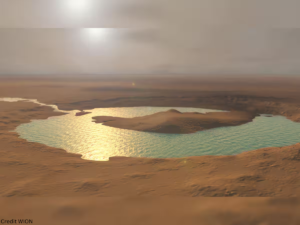Scientists are baffled by the most unexpected finding from NASA’s Curiosity Mars Rover: methane is leaking from Gale Crater’s surface.
The majority of methane produced on Earth is produced by living things. However, scientists didn’t expect to find methane on Mars because they haven’t discovered any solid evidence of ancient or present life there. Nevertheless, the mobile chemical laboratory on board Curiosity, dubbed Sample Analysis at Mars, or SAM for short, has been persistently sniffing for signs of the gas close to Gale Crater’s surface—the only location on Mars where methane has been found so far. Scientists believe that deep-seated geological processes involving water and rocks are its most likely cause.
Why does the Red Planet’s methane pass through some scientific instruments’ filters but not others?
It would be simple if that was the entire narrative. Methane in Gale Crater, however, exhibits peculiar behaviour, as discovered by SAM. Nighttime appearances are followed by daytime disappearances.

Seasonal variations occur, and occasionally it peaks at 40 times the average value. ESA’s (the European Space Agency) ExoMars Trace Gas Orbiter was sent to Mars expressly to research the gas in the atmosphere, and it has found no methane. This is surprising because methane doesn’t accumulate in the atmosphere either.
As stated by NASA‘s Southern California Jet Propulsion Laboratory project scientist Ashwin Vasavada, “it’s a story with a lot of plot twists.” Curiosity is being led by this lab.
In order to understand why methane acts strangely and is exclusively found in Gale Crater, scientists on Mars are constantly working in the lab and on computer modelling projects. An intriguing concept was recently made by a NASA research group.
The scientists proposed that methane, regardless of its production method, might be trapped beneath crystallised salt that could accumulate in Martian regolith, or “soil” composed of fractured rock and dust, and published their findings in a March publication in the Journal of Geophysical Research: Planets. Methane may leak out of the seal when temperatures rise during warmer months or hours of the day.
Researchers under the direction of NASA’s Goddard Space Flight Centre in Greenbelt, Maryland’s Alexander Pavlov, a planetary scientist, propose that seals cracking under the pressure of a small SUV-sized rover driving over them might likewise cause the gas to burst into puffs. Given that Gale Crater is one of just two locations on Mars where a robot is wandering and drilling the surface, Pavlov suggested that the team’s theory would help explain why methane is only identified there. (The other is the NASA Perseverance rover, which operates in Jezero Crater but lacks a methane detector.)
This hypothesis originated, according to Pavlov, from an unrelated experiment he conducted in 2017. The experiment entailed cultivating microorganisms in a frozen soil simulation of Martian permafrost, which is heavily loaded with salt.
Pavlov and his associates conducted research to see whether halophiles—a type of bacteria found in saline lakes and other salinity-rich settings on Earth—could flourish in a comparable environment on Mars.
He stated that although the microbe-growing results were inconclusive, the researchers discovered something unexpected: as the salty ice sublimated—that is, changed from a solid to a gas—the top layer of soil created a salt crust, releasing the salt in the process.
NASA declared in 2018 that ancient organic compounds that had been preserved in rocks for billions of years had been found by the Sample Analysis at Mars Chemistry Lab aboard the Curiosity Rover. Research like this one opens the door for future trips to the Red Planet and helps scientists comprehend how habitable early Mars was. Mars and Earth’s permafrost, courtesy of NASA’s Goddard Space Flight Centre
Although Pavlov stated, “We didn’t think much of it at the moment,” he recalled the soil crust incident from 2019 in which SAM’s tunable laser spectrometer discovered an unexplained methane burst.
That’s when it dawned on Pavlov. At that point, he and his colleagues started experimenting with the kinds of situations that could lead to the formation of cracks in hardened salt seals.
Read More Articles
Mark Zuckerberg seems to challenge Apple’s Vision Pro.
NASA’s Juno Provides Sky Views of Io’s Lava Lake and Mountains
Pavlov’s group examined five samples of permafrost that had been mixed with different amounts of perchlorate, a salt that is common on Mars. (Although Gale Crater probably lacks permafrost now, the seals may have developed long ago when Gale was icier and colder.) Within a NASA Goddard Mars simulation chamber, the scientists subjected each sample to varying temperatures and air pressures.
The methane analogue neon was periodically injected beneath the soil sample by Pavlov’s team, who then recorded the gas pressure both above and below it. The gas was likely trapped due to the higher pressure beneath the sample. In the end, only samples with a concentration of 5% to 10% perchlorate showed the formation of a seal under Mars-like circumstances in three to thirteen days.
That’s a lot more salt than Curiosity has measured in Gale Crater. However, the surrounding regolith is abundant in sulphates, a separate class of salt minerals that Pavlov’s team want to investigate further to determine whether they can also form seals.
The Curiosity rover has reached an area that is thought to have developed when Mars’s climate was drying out.
One of the main recommendations of the NASA Planetary Mission Senior Review for 2022 is to increase our understanding of the processes that produce and destroy methane on Mars. Pavlov’s theoretical work is essential to this effort. Scientists assert that more consistent methane readings are also necessary.
Principal investigator for SAM at Goddard, Charles Malespin, stated, “Methane experiments are resource intensive, so we have to be very strategic when we decide to do them.”
However, experts note that a new generation of surface devices that continually monitor methane from multiple locations around Mars would be necessary to assess the frequency of methane spikes.